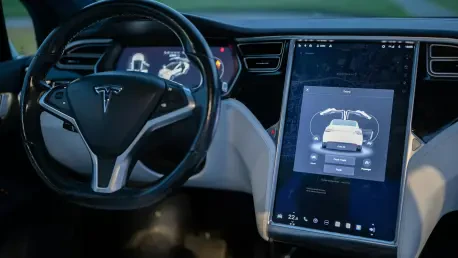In a world where urban congestion and environmental concerns are pressing harder than ever, the promise of autonomous vehicles offers a tantalizing glimpse into a future of seamless, sustainable transportation. Imagine cities like London and Berlin, known for their bustling streets and intricate road networks, becoming testing grounds for a new era of mobility where cars drive themselves, reducing accidents and emissions. This vision is no longer confined to science fiction, as two industry giants, Lyft and Baidu, have joined forces with an ambitious plan to roll out fully autonomous robotaxis in the United Kingdom and Germany by 2026. Their partnership combines cutting-edge technology with operational expertise, aiming to reshape how people move through some of Europe’s most dynamic urban centers. As this initiative unfolds, it raises critical questions about innovation, safety, and societal acceptance, setting the stage for a transformative shift in transportation.
Pioneering Autonomous Mobility in Europe
Harnessing Technological Innovation for Urban Travel
The collaboration between Lyft, a leader in ride-hailing, and Baidu, a powerhouse in autonomous driving technology, marks a significant step toward redefining urban travel. Baidu brings to the table its Apollo Go RT6, a vehicle engineered specifically for autonomous passenger transport, boasting a spacious, lounge-like interior that maximizes comfort by optionally removing the steering wheel. With millions of autonomous rides already completed in China, Baidu stands as a global leader in this space, offering a proven track record that lends credibility to the partnership. The goal is to integrate these vehicles into Lyft’s widely used app, ensuring a familiar interface for users while introducing a futuristic mode of transport. This technological synergy aims to deliver not just efficiency but also a safer, more reliable alternative to traditional ride-hailing, addressing urban challenges like traffic congestion and pollution in cities that desperately need innovative solutions.
Building on Strategic Partnerships and Local Expertise
Beyond technology, the success of this venture hinges on strategic alignments and local know-how, particularly through Lyft’s acquisition of FREENOW, a prominent European ride-hailing platform. This move provides an established network and crucial relationships with local authorities in the UK and Germany, smoothing the path for regulatory approvals and operational rollouts. The partnership envisions a hybrid model where autonomous vehicles coexist with human drivers, catering to a broad spectrum of customer preferences while maintaining service continuity. Both companies are committed to engaging with communities and policymakers to ensure responsible deployment, recognizing that trust and integration are as vital as the technology itself. By leveraging local insights and maintaining flexibility in their approach, Lyft and Baidu aim to create a transportation ecosystem that feels both innovative and accessible to European riders, setting a precedent for global expansion.
Navigating Challenges and Shaping Public Perception
Overcoming Regulatory and Urban Complexities
Deploying autonomous robotaxis in densely populated and unpredictable urban environments like London and Berlin presents a formidable challenge for Lyft and Baidu. Unlike the controlled settings where Baidu has previously operated, European cities feature narrow streets, heavy pedestrian traffic, and complex road systems that test the limits of self-driving technology. Regulatory bodies in the UK and Germany are known for their stringent standards, often adopting a cautious stance toward emerging technologies to prioritize public safety. Gaining approval requires not only demonstrating the reliability of the vehicles but also addressing concerns about data privacy and cybersecurity. The partnership must navigate these intricate landscapes with transparency and rigorous testing, ensuring that their systems can adapt to unique local conditions while meeting the high expectations set by both regulators and the public.
Addressing Public Skepticism and Industry Resistance
Equally daunting is the task of winning over a skeptical public and countering resistance from established stakeholders in the transportation sector. Safety concerns loom large, as autonomous vehicles must prove they can handle unexpected scenarios without human intervention, a worry amplified by past incidents in the industry. Taxi unions and advocacy groups in Europe have voiced opposition, fearing job losses and disruptions to traditional livelihoods. Public perception also varies widely, with some embracing the privacy and convenience of driverless cars, while others remain wary of entrusting their safety to algorithms. Lyft and Baidu must invest in education campaigns and pilot programs to build trust, showcasing tangible benefits like reduced accidents and lower costs. Balancing innovation with empathy for these concerns will be critical to ensuring that the rollout by 2026 is not just technologically feasible but also socially accepted.
Reflecting on a Bold Step Forward
Looking back, the journey of Lyft and Baidu to introduce autonomous robotaxis in Europe stood as a defining moment in the evolution of urban mobility. Their collaboration highlighted the immense potential of technology to address pressing transportation challenges, from safety to sustainability. Yet, it also underscored the intricate balance required between innovation and societal readiness. As they worked toward their 2026 target, the focus shifted to actionable strategies—forging stronger ties with regulators, investing in community outreach, and refining technology to meet the unique demands of European cities. The path ahead demanded continuous dialogue with stakeholders to ensure that the benefits of autonomous travel were clearly communicated and equitably shared. This pioneering effort not only aimed to transform how people moved but also set a blueprint for future global initiatives, emphasizing adaptability and collaboration as cornerstones of progress in an ever-changing world.









